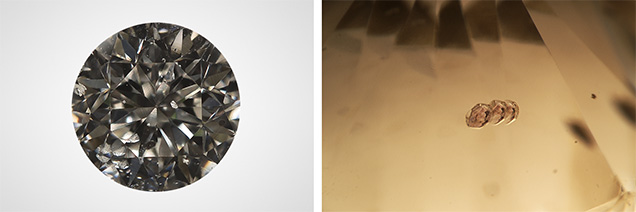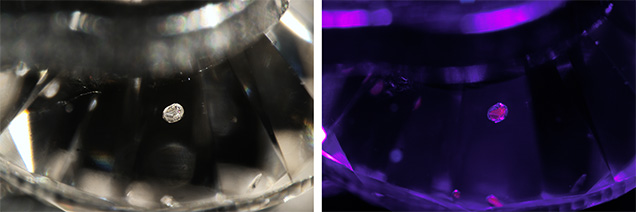Corundum Inclusions in Gem Diamond

Inclusions can tell us a great deal about a diamond’s formation history. Inclusions such as olivine, garnet, and chromite are more common, while others such as kyanite, zircon, and corundum (Al2O3) can be quite rare. Regardless of their rarity, diamond inclusions are often quite fascinating as they trap a small bit of the deep earth that cannot otherwise be sampled.
To our knowledge, the only previously recorded occurrence of chromium-bearing corundum (i.e., ruby or pink sapphire) as an inclusion in a gem diamond was nearly 40 years ago (H.O.A. Meyer and E. Gübelin, “Ruby in diamond,” Fall 1981 G&G, pp. 153–156). In that study, the 0.06 ct round brilliant diamond contained a surface-reaching ruby crystal. The exposed inclusion was analyzed using single-crystal X-ray diffraction, and chemical analysis was conducted using a reference ruby to calculate oxide percentages. At least two occurrences of blue corundum (i.e., sapphire) have also been reported (Summer 2006 Lab Notes, pp. 165–166; M.T. Hutchison et al., “Corundum inclusions in diamonds—discriminatory criteria and a corundum compositional dataset,” Lithos, Vol. 77, No. 1-4, 2004, pp. 273–286).
Here we report the second identification of chromium-rich corundum in a natural gem diamond. This diamond was discovered by Michael Turner at Stuller during routine screening for undisclosed laboratory-grown diamonds. Mr. Turner determined that it was type IIa using FTIR spectroscopy and then noted a peculiar chromium doublet emission in PL. The diamond was sent to the Carlsbad laboratory for further testing. Upon examination, the 0.13 ct round brilliant (figure 1, left) contained at least five internal inclusions that were positively identified as chromium-rich corundum (ruby or pink sapphire). The largest inclusion (figure 1, right) measured 0.18 mm long; the additional inclusions were 0.07 mm or smaller.
When viewed through the microscope with a diffuser plate, the largest of the inclusions displayed a very light pinkish color, while the rest exhibited no visible coloration. A DXR2xi Raman imaging microscope was used to create a map of the individual inclusions. These maps, consisting of thousands of individual Raman spectra, were analyzed and compared to Raman spectra from known corundum samples to determine that at least five of the inclusions in the diamond were in fact corundum (figure 2). A chromium doublet centered around 1369 and 1399 cm–1 (~693 and 694 nm) was also detected in the Raman spectra, further confirming that the corundum contained significant chromium. Also observed in the inclusions were additional luminescence peaks that are not typical of diamond (figure 3). In particular, a 704 nm peak was localized around the corundum inclusions.


After identifying the inclusions, we tested their reaction to UV light. Under illumination from a long-wave ultraviolet light source (365 nm), the largest one displayed a beautiful deep red color (figure 4). Ruby and pink sapphire typically exhibit a weak to strong red color when exposed to long- and short-wave UV due to fluorescence from abundant chromium impurities; the same was observed for some of the corundum inclusions within this diamond. Other corundum inclusions were either too weak to photograph or did not display any visible reaction to UV light.
Previous research by G.R. Watt et al. (“A high-chromium corundum (ruby) inclusion in diamond from the São Luiz alluvial mine, Brazil,” Mineralogical Magazine, Vol. 58, No. 392, 1994, pp. 490–493) and Hutchison et al. (2004) found that inclusions of corundum (colorless, ruby, and sapphire) in their non-gem type II diamonds contained large amounts of chromium and nickel. Both studies declared the diamonds to be sublithospheric in origin with an eclogitic paragenesis due to the association of the corundum inclusions with other deep-mantle inclusions. We did not perform chemical analysis on the inclusions described here because they were entirely encased within the diamond. While we cannot determine the depth of formation for this diamond, it can be reasonably inferred, based on previous studies, to have a sublithospheric origin and eclogitic paragenesis, as Al2O3 is rare in peridotitic mantle. Opportunities to examine diamonds containing rare inclusions provide an intriguing glimpse into the deep earth.

It is with great sadness that we note the passing of Michael Turner. Michael was a well-respected contributor to GIA, and he will be dearly missed.
.jpg)


